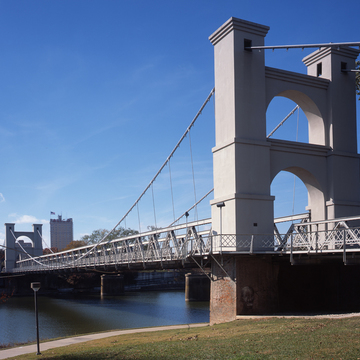The 475-foot structure crosses the Brazos River near the central business district on axis with Austin Street. In 1866, Joseph Speight created the Waco Bridge Company, which hired New York engineer Griffith to design and John A. Roebling and Son of New York (later contractors for the Brooklyn Bridge) to construct the suspension bridge. The cables drape from arcaded masonry towers and are anchored in crenellated gatehouses. The bridge greatly facilitated the river crossing of millions of long-horn cattle trailed out of southern Texas to the Kansas railheads and brought a much-needed boost to Waco's post–Civil War economy. In 1971, the city discontinued use of the bridge for vehicles and adapted it for pedestrians, connecting riverside parks on both banks of the Brazos River.
You are here
Waco Suspension Bridge
If SAH Archipedia has been useful to you, please consider supporting it.
SAH Archipedia tells the story of the United States through its buildings, landscapes, and cities. This freely available resource empowers the public with authoritative knowledge that deepens their understanding and appreciation of the built environment. But the Society of Architectural Historians, which created SAH Archipedia with University of Virginia Press, needs your support to maintain the high-caliber research, writing, photography, cartography, editing, design, and programming that make SAH Archipedia a trusted online resource available to all who value the history of place, heritage tourism, and learning.


